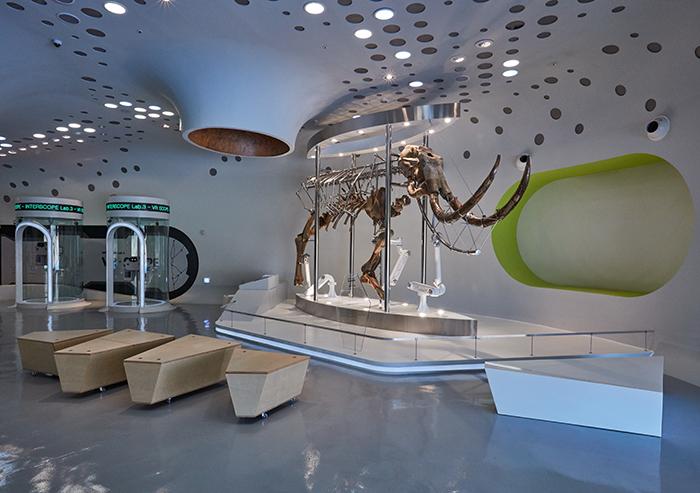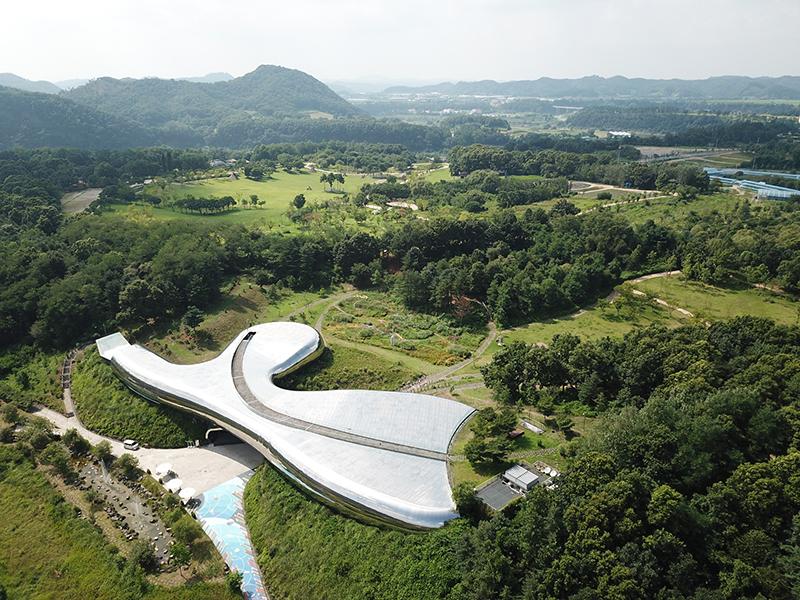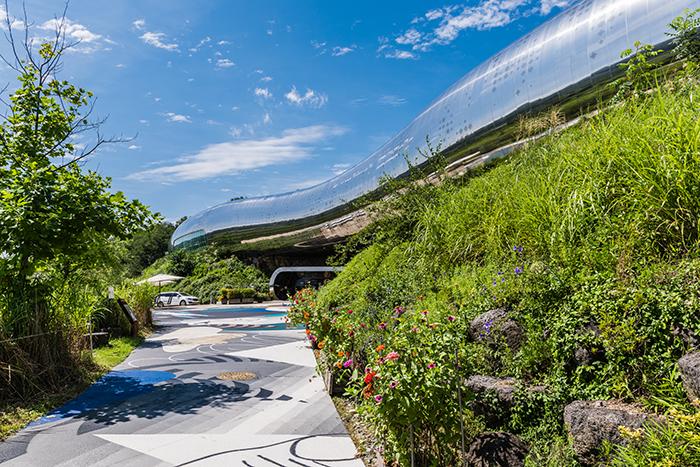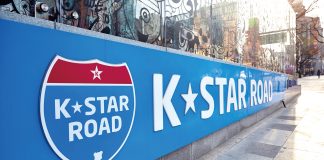Art museum embraced by nature
Museum SAN
Tadao Ando | Japan

Sitting atop a mountain, Museum SAN has a long and narrow layout. When Tadao Ando first visited the site before constructing the museum, he was attracted by the area’s charm of being surrounded by nature and away from the hustle and bustle of the city. He thought maybe he would be able to create a whole new world here. Ando’s first impression of the spot is reflected in the museum’s design. You can feel his design concept of “Disconnect to Connect” as you walk along the 700m-long pathway and tour the exhibition halls.

Ando’s architectural style of highlighting “dramatic sequence and contrasts” can also be found at Museum SAN, leaving a great impression on visitors. The Welcome Center has a rather dark and reclusive ambiance inside. However, once you exit the building, you will see the large Flower Garden, the first contrast on the way to the museum. From the Flower Garden covered with rainbow pinks, a long pathway leads you through a birch forest, and finally to the quiet Water Garden, where the beautiful sky can be seen reflected on it. You will feel connected and interacting with nature.

The museum at the end of the pathway is designed in a “box within a box” concept, whereby an unrefined stone “box” made with Pajuseok stones (coarse stones produced in the Paju region of Korea) houses exhibition “boxes” with exposed concrete exteriors. Light shining through the ceilings of the hallways surrounding the exposed concrete “boxes,” create a mysterious effect. Along the hallways you will witness the well-sequenced contrasts between opening and closing, connection and disconnection, inside and outside, as well as art and nature. You will find yourself immersed in this unique and mystical architectural space.

Once you exit the museum, a vast open space called the Stone Garden awaits you. This outdoor space consists of nine stone mounds inspired by ancient tombs from the Silla Kingdom (57BCE–935CE). As you walk across the garden surrounded by the peaceful atmosphere created by the sky, land, wind, and sunlight, you will be reminded again of the connection and interaction with nature.

TIP
You can take the Wonju City Tour Bus (Circulating) at the Wonju Intercity Bus Terminal and visit major tourist attractions in Wonju including Museum SAN.
9 buses/day(wonjutourbus.kr)
TOURIST ATTRACTIONS
• Ganhyeon Tourist Area
• Miro Arts Wonju Jungang Market
Address
260 Oak valley 2-gil, Jijeong-myeon, Wonju-si, Gangwon-do
Way
Shuttle bus (5 buses/day) or taxi (25mins; 30,000won) from Wonju Intercity Bus Terminal
Tel
033-730-9000
Admission
18,000won
Website
www.museumsan.org
Time
10:00–18:00 (Closed on Mondays)
Video art as part of architecture
Nam June Paik Art Center
Kirsten Schemel, Maina Stankovic | Germany

This space was built to study and exhibit the artistic ideas and the creative artwork of Nam June Paik (1932–2006), world-famous artist and “father of video art.” Paik created experimental artworks by manipulating the circuit of Braun-tube televisions to change what is displayed on the screen or by encouraging the audience to take part in completing his work. He continued to pursue experimental art, removing barriers between art and technology, humans and machinery, as well as East and West. Elizabeth Broun, the director of the Smithsonian American Art Museum, said
“If Picasso stands astride the first half of the 20th century like a colossus, Nam June Paik is the center of gravity for all that was new in the second half of that 100-year span. We are only now learning how profoundly his imagination embraced and transformed our world.”
In 2003, an international design contest was held to design an art center reflecting Paik’s thoughts and views on art. A total of 439 teams from 42 countries joined the contest for the world-famous artist, and “The Matrix” designed by Kirsten Schemel won. Schemel said she was deeply impressed by Paik’s artwork, which arouses viewers’ indefinite imagination, and designed a concept whereby unlike existing galleries and museums, viewers take the leading role and freely select spaces.


The exterior of the museum is surrounded by vertically fragmented glass curtain walls. The interior side of the double reflected glass windows is silk-screened so that visitors can see the outdoors more vividly while inside. In particular, the black horizontal lines on the glass curtain walls remind viewers of the coarse vertical test pattern lines of black and white televisions. The image of the natural landscape reflected on the glass curtain walls, combined with the horizontal lines, looks like a gigantic video artwork by Paik.

TIP
Zien Art Space, located across from Nam June Paik Art Center, is a cultural complex consisting of exhibition, education and creative spaces, as well as the Zien Shop, a café and a restaurant.
TOURIST ATTRACTIONS
• Zien Art Space
• Gyeonggi Province Museum
• Korean Folk Village
Address
10 Paiknamjune-ro, Giheung-gu, Yongin-si, Gyeonggi-do
Way
15-min walk from Exit 6 of Giheung Station, Ever or Bundang Line
Tel
031-201-8571
Admission
Free
Website
njp.ggcf.kr
Time
10:00–18:00 (July & Aug until 19:00; Closed Mondays)
Time travel to the prehistoric era
Jeongok Prehistory Museum
X-TU Architects | France

Jeongok Prehistory Museum is located in Jeongok-ri, where East Asia’s first Acheulean hand ax1 was found in 1979. According to the dramatic story behind the discovery, a senior airman in the US Air Force based in Korea found a stone while out on a date near the Hantangang River in Jeongok-ri. Having studied archeology before stationed in Korea, the senior airman recognized that the stone his girlfriend picked-up was an Acheulean hand ax.

The museum built on the very site, stretches between two hills with a stream in the middle, as if it were a bridge. The exterior of the museum resembles a primitive animal covered in stainless steel. The exterior shines under daylight, and the reflection on the metallic surface moves like waves depending on the viewing angle.

The architect was inspired by the dragons that appear in Korean mythology and reflected this idea when designing the exterior surface. Small punctures of different forms were finished with semi-transparent materials to make them look like dragon scales. At night, the indoor lighting, which is programmed to change direction and brightness, shines through these small holes as if the building were alive.


The museum, standing on a vast field surrounded by mountains and rivers, is a grand sculpture in itself. Particularly in the evening, when the sun starts to fall, the curved metallic exterior of the museum creates a spectacular skyline.


















![[A ZONE] Gangnam Food Spot](https://www.dgram.co.kr/wp-content/uploads/2020/09/A존-알래스카3-특성이미지_S-324x160.jpg)
![[A ZONE] Gangnam Life Style](https://www.dgram.co.kr/wp-content/uploads/2020/09/로우클래식1-특성이미지_S-324x160.jpg)





Wowww~